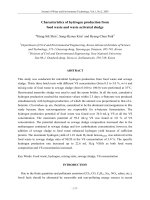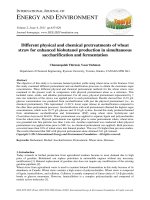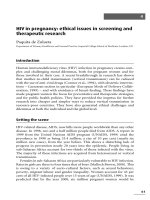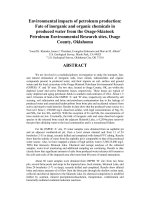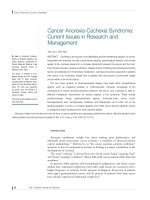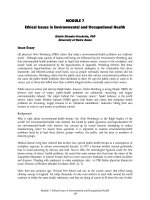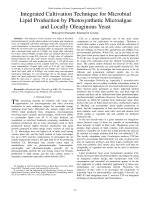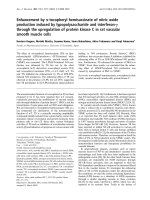Special Production Issues: Lost Units and Accretion
Bạn đang xem bản rút gọn của tài liệu. Xem và tải ngay bản đầy đủ của tài liệu tại đây (394.7 KB, 42 trang )
7
Special Production Issues:
Lost Units and Accretion
CHAPTER
LEARNING OBJECTIVES
After completing this chapter, you should be able to answer the following questions:
1
What is an accepted quality level and how does it relate to zero tolerance for errors and defects?
2
Why do lost units occur in manufacturing processes?
3
How do normal and abnormal losses of units differ and how is each treated in an EUP schedule?
4
How are the costs of each type of loss assigned?
5
How are rework costs of defective units treated?
6
How are losses treated in a job order costing system?
7
How does accretion of units affect the EUP schedule and costs per unit?
8
What is the cost of quality products?
General
Electric
Company
INTRODUCING
homas Alva Edison invented the first successful
incandescent light bulb in 1879. Shortly thereafter,
General Electric (GE) began providing power and lighting
up America and the world. General Electric Company was
formed in 1892 through a merger of Edison Electric Light
Company and Thomson-Houston Company.
Today, GE is the world’s largest diversified services
company as well as a provider of high-quality, high-
technology industrial and consumer products. While main-
taining world-class leadership in its beginnings in providing
power systems and electric lighting, the company has ex-
panded into many areas. A few examples include aircraft
engines, medical systems, financial services, television
broadcasting, and transportation systems. GE consists of
more than three dozen businesses operating in 100 com-
panies around the globe. Although widely diverse, GE
businesses are also highly familial and share information,
resources, technology, and intellectual capital.
GE’s sharing among all its businesses includes:
1. a common operating system and a social architecture
characterized by boundaryless behavior,
2. a common leadership development system,
3. one set of common values, and
4. four common initiatives—globalization, product services,
e-business, and Six Sigma quality.
Six Sigma is a quality management term used to
define a process for eliminating variation and, therefore,
eliminating defects. Statistically, Six Sigma quality means
improving manufacturing quality to six standard deviations
from the specification limit. This translates to a rate of 3.4
defects out of a million items processed. GE is absolutely
committed to delivering flawless products and services to
its customers.
At GE, the Six Sigma initiative is in its fifth year—its
fifth trip through the operating system. From a standing
start in 1996, with no financial benefit to the company, it
has flourished to the point where it provided more than
$2 billion in benefits in 1999, with much more to come
this decade.
Unlike the General Electric (GE) processes that have been subjected to zero-defect
tolerance, most companies tolerate some level of defects by establishing an accepted
quality level (AQL) for their production or service processes. AQL is the maximum
limit for the number of defects or errors in a process. If the percentage of defects
or errors is less than the AQL, the company considers that it has performed at an
acceptable quality level.
Companies viewed as having world-class status in a particular endeavor seek
to continuously tighten the accepted quality level. Thus, producing goods with zero
defects and performing services with zero errors are laudable goals and ones toward
which domestic and foreign companies are striving.
The examples in Chapter 6 assumed that all units to be accounted for have
either been transferred or are in ending work in process inventory; however, almost
every process produces some units that are spoiled or do not meet production
specifications. Phenomena in the production process also may cause the total units
accounted for to be less than the total units to account for. In other situations
(unrelated to spoiled units), the addition or expansion of materials after the start
of the process may cause the units accounted for to be greater than those to be
accounted for originally or in a previous department.
This chapter covers these more complex issues of process costing. Spoiled and
defective units, reworking of defective units, and accretion require adjustments to
the equivalent units of production (EUP) schedule and cost assignments made at
the end of a period. The last section of this chapter discusses controlling quality
so that only a minimal number of inferior goods are produced.
SOURCES
: General Electric Company Web site, (June 2000); Robert Buderi, “The Six Sigma Approach Revs Up,”
Upside
(May 2000), p. 50.
261
T
What is an accepted quality level
and how does it relate to zero
tolerance for errors and defects?
accepted quality level (AQL)
1
Part 2 Systems and Methods of Product Costing
262
LOSS OF UNITS
Few, if any, processes combine material, labor, and overhead with no loss of units.
Some of these losses, such as evaporation, leakage, or oxidation, are inherent in the
production process. For example, when Starbucks roasts coffee beans, approximately
20 percent of the original weight is lost from water evaporation. This situation results
in shrinkage. Modifying the production process to reduce or eliminate the causes of
shrinkage may be difficult, impossible, or simply not cost beneficial.
Spoilage of some food products occurs simply by exposure to the atmosphere
wherever perishable foods are processed or stored. In this regard, Louisiana State
University and SIRA Technologies have developed a new monitoring system for
meat that can enable meat processors and food retailers to better regulate the safety
requirements for storage and prevent loss of reputation and revenue from selling
meat containing harmful bacteria. The technology uses a bar code treated with an-
tibodies that are sensitive to virulent strains of bacteria.
1
As discussed in the ac-
companying News Note, spoilage of meats and other perishable foods awaiting
customer purchases in supermarkets can be further prevented by covering refrig-
eration cases each night.
At other times, errors in the production process (either by humans or machines)
cause a loss of units through rejection at inspection for failure to meet appropriate
quality standards or designated product specifications. Whether these lost units are
Why do lost units occur in
manufacturing processes?
shrinkage
2
1
Ginger Koloszyc, “New Bar-Code Technology Detects Meat Spoilage,” Stores (October 1998), p. 72.
Closing the Curtain on Contaminants
NEWS NOTE QUALITY
It is estimated that 75% of the supermarkets in North
America are closed to the public for 6 to 8 hours at night.
With little effort, these supermarkets could claim dollars
that are lost during the stores’ closed hours from unnec-
essary energy consumption and premature spoilage of
many perishable products.
Open refrigerated display cases are the best way for
retailers to present fresh merchandise to consumers. Un-
fortunately, these cases are also open to the effects of
heat and UV radiation from the store environment.
There is often a misconception that the refrigerated
air escapes from the display case. However, heat or
warm air is actually drawn toward the colder air, raising
the temperatures in the display case; this causes mer-
chandise to warm up and compressors to operate more
frequently.
More frequent compressor operation and exposed
products must be tolerated so that consumers can shop
freely, but when the store is closed, simple steps can be
taken to reduce store energy consumption and extend
product shelf life with ideal cold temperatures.
To solve this problem, an efficient temperature barrier
is needed between the opening of the display case and
the store interior. The ideal thermal barrier arrangement
must have several qualities to be effective in increasing
store profit:
• Reasonable cost and quick initial payback period;
• Simple and quick to put in operation;
• No interference with customer access to fresh mer-
chandise when the store is open;
• No disturbance to the cosmetic appearance of the
store;
• Durable commercial quality;
• Hygienic (will not rust or attract dust, mold, and
mildew);
• Simple, quick cleaning maintenance that can be
done when cleaning the case; and
• Effective in the reflection of heat and UV radiation.
A vertical rolling curtain permanently attached to the top
of the display was agreed upon as the simplest and eas-
iest to use arrangement. To adapt to this arrangement, a
99% pure aluminum heat-reflective fabric was developed.
To provide strength to the woven aluminum fabric and elim-
inate oxidation, it is coated with a thin, transparent film.
SOURCE
: Staff, “The Big Cover-Up in the Refrigeration Case,”
Air Conditioning,
Heating, and Refrigeration News
(April 3, 2000), pp. 27ff.
atechnologies
.com
considered defective or spoiled depends on their ability to be economically re-
worked. Economically reworked means that (1) the unit can be reprocessed to
a sufficient quality level to be salable through normal distribution channels and
(2) incremental rework cost is less than incremental revenue from the sale of re-
worked units. A defective unit can be economically reworked, but a spoiled unit
cannot. An inspector in the company making the product determines which are
defective and which are spoiled.
To illustrate the difference between defective and spoiled units, assume you
order blackened redfish at a restaurant. You are now the control inspector. If the
redfish brought to you is barely blackened, it is a defective unit because the chef
can cook it longer to bring it up to “product specifications.” The incremental rev-
enue is the selling price of the redfish; the incremental cost is a few moments of
the chef’s time. However, if the fish brought to you is blackened to a cinder, it is
a spoiled unit because it cannot be reworked. Therefore, a newly cooked black-
ened redfish would have to be provided.
A normal loss of units falls within a tolerance level expected during pro-
duction. Management creates a range of tolerance of spoiled units specified by the
accepted quality level, as mentioned in the beginning of this chapter. If a com-
pany had set its quality goal as 98 percent of goods produced, the company would
have been expecting a normal loss of 2 percent. Any loss in excess of the AQL is
an abnormal loss. Thus, the difference between normal and abnormal loss is
merely one of degree and is determined by management.
A variety of methods can be used to account for units lost during production.
Selection of the most appropriate method depends on two factors: (1) the cause
of the decrease and (2) management expectations regarding lost units. Under-
standing why units decreased during production requires detailed knowledge of
the manufacturing process. Management’s expectations are important to determine
the acceptable loss quantities from defects, spoilage, or shrinkage as well as the
revenue and cost considerations of defective and spoiled units.
Chapter 7 Special Production Issues: Lost Units and Accretion
263
economically reworked
defective unit
spoiled unit
How do normal and abnormal
losses of units differ and how is
each treated in an EUP
schedule?
normal loss
abnormal loss
3
TYPES OF LOST UNITS
In developing the product design, manufacturing process, and product quality,
management selects a combination of material, labor, and overhead from the wide
resource spectrum available. This combination is chosen to provide the lowest long-
run cost per unit and to achieve the designated product specifications—including
those for quality. In making this resource combination choice, managers recognize
that, for most combinations, some degree of production error may occur that will
result in lost units. Given the resource choices made by management, the quan-
tity or percentage of lost units to be generated in a given period or production
run should be reasonably estimable. This estimate is the normal loss because it is
planned for and expected. Normal loss is usually calculated on the basis of good
output or actual input.
Some companies may estimate the normal loss to be quite high because the
lowest cost material, labor, or overhead support is chosen. For example, assume
that Scrape Manufacturing Ltd. chooses to install the least advanced, lowest cost
machinery for production purposes because its workers do not have the educa-
tional or technological skills to handle the more advanced equipment. The installed
equipment may have fewer quality checks and, thus, produce more spoiled units
than the more advanced equipment. Scrape’s managers have decided that the costs
of upgrading worker skills were greater than the cost of lost units.
Another reason for high estimated normal losses relates not to the resources
chosen, but to a problem inherent in the product design or in the production
process. In other cases, based on cost-benefit analysis, managers may find that a
problem would cost more to eliminate than to tolerate. For example, assume a
machine malfunctions once every 100 production runs and improperly blends in-
gredients. The machine processes 50,000 runs each year and the ingredients in
each run cost $10. Correcting the problem has been estimated to cost $20,000 per
year. Spoilage cost is $5,000 per year (500 spoiled batches ϫ $10 worth of ingre-
dients) plus a minimal amount of overhead costs. If company employees are aware
of the malfunction and catch every improperly blended run, accepting the spoilage
is less expensive than correcting the problem.
If, alternatively, the spoiled runs are allowed to leave the plant, they may
create substantial quality failure costs in the form of dissatisfied customers and/or
salespeople who might receive the spoiled product. Managers in world-class com-
panies should be aware that the estimate of the cost to develop a new customer
is $50,000, five times as much as the estimated cost of keeping an existing one.
2
In making their cost-benefit analysis, managers must be certain to quantify all the
costs (both direct and indirect) involved in spoilage problems.
An abnormal loss is a loss in excess of the normal, predicted tolerance limits.
Thus, when an abnormal loss occurs, so does a normal loss (unless zero defects
have been set as the AQL). Abnormal losses generally arise because of human or
machine error during the production process. For example, if the tolerances on
one of a company’s production machines were set incorrectly, a significant quan-
tity of defective products might be produced before the error was noticed. Because
abnormal losses result from nonrandom, special adverse conditions and actions,
they are more likely to be preventable than some types of normal losses.
Realistically, units are lost in a production process at a specific point. How-
ever, accounting for lost units requires that the loss be specified as being either
continuous or discrete. For example, the weight loss in roasting coffee beans and
the relatively continual breakage of fragile glass ornaments can be considered
continuous losses because they occur fairly uniformly throughout the production
process.
In contrast, a discrete loss is assumed to occur at a specific point. Examples
of discrete losses include adding the wrong amount of vinegar to a recipe for salad
dressing or attaching a part to a motor upside down. The units are only deemed
lost and unacceptable when a quality check is performed. Therefore, regardless of
where in the process the units were truly “lost,” the loss point is always deemed
to be an inspection point. Thus, units that have passed an inspection point should
be good units (relative to the specific characteristics inspected), whereas units that
have not yet passed an inspection point may be good or may be defective/spoiled.
Control points can be either built into the system or performed by inspectors.
The former requires an investment in prevention costs; the latter results in appraisal
costs. Both are effective, but prevention is often more efficient because acceptable
quality cannot be inspected into a product; it must be a part of the production
process. Investments to prevent lost units may relate either to people or machines.
(Prevention costs and appraisal costs are formally defined in Chapter 8.)
In determining how many quality control inspection points (machine or human)
to install, management must weigh the costs of having more inspections against the
savings resulting from (1) not applying additional material, labor, and overhead to
products that are already spoiled or defective (direct savings) and (2) the reduction
or elimination of internal and external failure costs (indirect savings). Quality control
points should always be placed before any bottlenecks in the production system so
that the bottleneck resource is not used to process already defective/spoiled units.
Additionally, a process that generates a continuous defect/spoilage loss requires a
quality control point at the end of production; otherwise, some defective/spoiled
units would not be found and would be sent to customers, creating external failure
costs. (Failure costs are formally defined in Chapter 8.)
Part 2 Systems and Methods of Product Costing
264
2
Peter L. Grieco, Jr., “World-Class Customers,” Executive Excellence (February 1996), p. 10.
continuous loss
discrete loss
Chapter 7 Special Production Issues: Lost Units and Accretion
265
How are the costs of each type
of loss assigned?
4
ACCOUNTING FOR LOST UNITS
The method of accounting for the cost of lost units depends on whether the loss
is considered normal or abnormal and whether the loss occurred continuously in
the process or at a discrete point. Exhibit 7–1 summarizes the accounting for the
cost of lost units.
The traditional method of accounting for normal losses is simple. Normal loss
cost is considered a product cost and is included as part of the cost of the good
units resulting from the process. Thus, the cost of the loss is inventoried in Work
in Process and Finished Goods Inventories and expensed only when the good units
are sold. This treatment has been considered appropriate because normal losses
have been viewed as unavoidable costs in the production of good units. If the loss
results from shrinkage caused by the production process, such as the weight loss
of roasting coffee beans, this treatment seems logical.
Alternatively, consider the company producing fragile scientific lenses: If the
company allows for losses by virtue of the level at which some acceptable qual-
ity was set, then management will not receive valuable information about the cost
of quality losses. In contrast, if the same company were to institute a zero-defect
policy, there would by definition be no “normal” loss. All losses would be outside
the tolerance specifications for acceptable quality.
The costs of normal shrinkage and normal continuous losses are handled
through the method of neglect, which simply excludes the spoiled units in the
equivalent units schedule. Ignoring the spoilage results in a smaller number of
equivalent units of production (EUP) and, by dividing production costs by a smaller
EUP, raises the cost per equivalent unit. Thus, the cost of lost units is spread pro-
portionately over the good units transferred and those remaining in Work in Process
Inventory.
Alternatively, the cost of normal, discrete losses is assigned only to units that
have passed the inspection point. Such units should be good units (relative to the
inspected characteristic), whereas the units prior to this point may be good or may
be defective/spoiled. Assigning loss costs to units that may be found to be defective/
spoiled in the next period would not be reasonable.
EXHIBIT 7–1
Continuous versus Discrete
Losses
Uniformly throughout
process
or
Absorbed by all units
in ending inventory
and transferred out
on an EUP basis
At inspection point or
at end of process
Absorbed by all units
past inspection point in
ending inventory and
transferred out on an
EUP basis
Type
Continuous
Assumed to Occur May Be Cost Handled How?
Discrete
Normal
Cost Assigned To?
Written off as a loss
on an EUP basis
Abnormal
Product
Period
or
Normal
Abnormal
Product
Period
Written off as a loss
on an EUP basis
method of neglect
Regardless of whether defects/spoilage occur in a continuous or discrete fash-
ion, the cost of abnormal losses should be accumulated and treated as a loss in
the period in which those losses occurred. This treatment is justified by the cost
principle discussed in financial accounting. The cost principle allows only costs
that are necessary to acquire or produce inventory to attach to it. All unnecessary
costs are written off in the period in which they are incurred. Because abnormal
losses are not necessary to the production of good units and the cost is avoidable
in the future, any abnormal loss cost is regarded as a period cost. This cost should
be brought to the attention of the production manager who should then investi-
gate the causes of the loss to determine how to prevent future similar occurrences.
Abnormal loss cost is always accounted for on an equivalent unit basis.
Part 2 Systems and Methods of Product Costing
266
ILLUSTRATIONS OF LOST UNITS
To best understand how to account for a process that creates lost goods, it is help-
ful to know the answers to the following questions:
1. What is the process flow?
2. Where is material added during the process?
3. How are labor and overhead applied? (This answer is usually “Continuously,”
but not necessarily at the same rate.)
4. At what stage of completion was the beginning inventory and what is the end-
ing inventory?
5. Where are the quality control inspection points?
6. How do defective/spoiled units occur? (Continuously or discretely?)
Impervious Inc. is used to illustrate several alternative situations regarding the
handling of lost units in a process costing environment. Impervious produces a high-
tech, very durable, nonfade (once color pigment is added) paint base material—
hereafter simply referred to as paint—for appliances and equipment. The paint is
produced in a single department and then sold to appliance and equipment man-
ufacturers. All materials are added at the start of the process, and conversion costs
are applied uniformly throughout the production process. Recyclable containers are
provided by buyers and, therefore, are not a cost to Impervious. The company
uses the FIFO method of calculating equivalent units.
Spoilage in the production of
CD-ROMs can occur from a
wide variety of causes and at
numerous points in the produc-
tion process. Because spoilage
tends to be machine-related,
quality checks are built into the
production system and are often
performed robotically. However,
the final quality control analysis
is performed by a replication
operator.
Situation 1—Normal Loss Only; Loss Occurs Throughout
Production Process (Continuous)
During processing, the paint is mechanically blended and cooked, resulting in a
normal loss from shrinkage. Mechanical malfunctions sometimes occur and, when
they do, cause some spoilage. Any decrease of 10 percent or less of the gallons
placed into production for a period is considered normal. The April 2000 data for
Impervious are given below:
GALLONS
Beginning inventory (60% complete) 2,000
Started during month 15,000
Gallons completed and transferred 13,200
Ending inventory (75% complete) 2,500
Lost gallons (normal) 1,300
COSTS
Beginning inventory:
Material $ 15,000
Conversion 1,620 $ 16,620
Current period:
Material $102,750
Conversion 19,425
122,175
Total costs $138,795
To visualize the manufacturing process for Impervious, a flow diagram can be
constructed. Such a diagram provides distinct, definitive answers to all of the ques-
tions asked at the beginning of this section.
Flow Diagram
→ Conversion cost applied uniformly throughout →
↑
↑↑
↑
60% 75% 100%
Material Beginning Ending Inspection
added inventory inventory point
→ Continuous reduction in units (shrinkage) →
The steps discussed in Chapter 6 on process costing are followed to determine
the units accountable for, units accounted for, equivalent units of production, costs
accountable for, cost per equivalent unit, and cost assignment. These steps are pre-
sented in the cost of production report shown in Exhibit 7–2.
The department is accountable for 17,000 gallons of paint: 2,000 gallons in be-
ginning inventory plus 15,000 gallons started into processing during April. Only
15,700 gallons (13,200 completed and 2,500 in ending inventory) are accounted for
prior to considering the processing loss. The 1,300 lost gallons are included in the
schedule of gallons accounted for to balance to the total 17,000 gallons, but these
gallons are not extended into the computation of equivalent units of production.
Using the method of neglect, these gallons simply “disappear” in the EUP sched-
ule. Thus, the cost per equivalent gallon of the remaining good production of the
period is higher for each cost component.
Had the lost gallons been used in the denominator of the cost per EUP com-
putation, the cost per EUP would have been smaller, and the material cost per unit
would have been $6.85 ($102,750 Ϭ 15,000). Because the lost units do not appear in
the cost assignment section, their costs must be assigned only to good production.
The use of the lower cost per EUP would not allow all of the costs to be accounted
for in Exhibit 7–2.
Chapter 7 Special Production Issues: Lost Units and Accretion
267
Accounting for normal, continuous shrinkage (or defects/spoilage) is the eas-
iest of the types of lost unit computations. There is, however, a theoretical prob-
lem with this computation when a company uses weighted average process cost-
ing. The units in ending Work in Process Inventory have lost unit cost assigned to
them in the current period and will have lost unit cost assigned again in the next
period. But, even with this flaw, this method provides a reasonable measure of
unit cost if the rate of spoilage is consistent from period to period.
Situation 2—Normal Spoilage Only; Spoilage Determined at
Final Inspection Point in Production Process (Discrete)
This example uses the same basic cost and unit information given above for Im-
pervious Inc. except that no shrinkage occurs. Instead, the paint is inspected at
the end of the production process. Any spoiled gallons are removed and discarded
at inspection; a machine malfunction or an improper blending of a batch of paint
usually causes spoilage. Any spoilage of 10 percent or less of the gallons placed
into production during the period is considered normal. A production flow diagram
is shown at the top of the next page.
Part 2 Systems and Methods of Product Costing
268
PRODUCTION DATA EQUIVALENT UNITS
Whole
Units Material Conversion
Beginning inventory (100%; 60%) 2,000
Gallons started 15,000
Gallons to account for 17,000
Beginning inventory completed
(0%; 40%) 2,000 0 800
Gallons started and completed 11,200 11,200 11,200
Total gallons completed 13,200
Ending inventory (100%; 75%) 2,500 2,500 1,875
Normal shrinkage 1,300
Gallons accounted for 17,000 13,700 13,875
COST DATA
Total Material Conversion
Beginning inventory costs $ 16,620
Current costs 122,175 $102,750 $19,425
Total costs $138,795
Divided by EUP 13,700 13,875
Cost per FIFO EUP $8.90 $7.50 $1.40
COST ASSIGNMENT
Transferred:
Beginning inventory $16,620
Cost to complete: Conversion (800 ϫ $1.40) 1,120
Total cost of beginning inventory $17,740
Started and completed (11,200 ϫ $8.90) 99,680
Total cost of gallons transferred $117,420
Ending inventory:
Material (2,500 ϫ $7.50) $18,750
Conversion (1,875 ϫ $1.40) 2,625 21,375
Total costs accounted for $138,795
EXHIBIT 7–2
Cost of Production Report for
Month Ended April 30, 2000
(FIFO method) (Normal
continuous shrinkage)
→ Conversion cost applied uniformly throughout →
↑
↑↑
↑
60% 75% 100%
Material Beginning Ending Inspection
added inventory inventory point
(discrete
spoilage)
In this situation, the spoiled gallons of product are included in the equivalent
unit schedule. Because the inspection point is at 100 percent completion, all work
has been performed on the spoiled gallons and all costs have been incurred to
produce those gallons. By including the spoiled gallons at 100 percent completion
in the EUP schedule, cost per gallon reflects the cost that would have been in-
curred had all production been good production.
Cost of the spoiled gallons is assigned solely to the completed units. Because
ending Work in Process Inventory has not yet passed the inspection point, this in-
ventory may contain its own normal spoilage, which will be detected next period.
The cost of production report for Situation 2 is shown in Exhibit 7–3.
Situation 3—Normal Spoilage Only; Spoilage Determined
During Production Process (Discrete)
In this example, Impervious Inc. inspects the paint when the conversion process is
50 percent complete. The only difference between this example and the previous one
is that, for April, the ending Work in Process Inventory has passed the inspection
point. Because of this difference, spoilage cost must be allocated to both the gallons
transferred and to ending inventory. Although the ending inventory could become
spoiled during the remainder of processing, it is either highly unlikely or the cost
Chapter 7 Special Production Issues: Lost Units and Accretion
269
PRODUCTION DATA EQUIVALENT UNITS
Whole
Units Material Conversion
Beginning inventory (100%; 60%) 2,000
Gallons started 15,000
Gallons to account for 17,000
Beginning inventory completed
(0%; 40%) 2,000 0 800
Gallons started and completed 11,200 11,200 11,200
Total gallons completed 13,200
Ending inventory (100%; 75%) 2,500 2,500 1,875
Normal spoilage (100%; 100%) 1,300 1,300 1,300
Gallons accounted for 17,000 15,000 15,175
COST DATA
Total Material Conversion
Beginning inventory costs $ 16,620
Current costs 122,175 $102,750 $19,425
Total costs $138,795
Divided by EUP 15,000 15,175
Cost per FIFO EUP $8.13 $6.85 $1.28
(continued)
EXHIBIT 7–3
Cost of Production Report for
Month Ended April 30, 2000
(FIFO method) (Normal discrete
spoilage)
is so minimal that Impervious cannot justify the need for an end-of-process in-
spection. The flow diagram for this situation follows:
→ Conversion cost applied uniformly throughout →
↑
↑↑↑
↑
50% 60% 75% 100%
Material Inspection Beginning Ending
added point inventory inventory
(discrete
spoilage)
Using the same data as in the two previous situations, Exhibit 7–4 provides
the cost per gallon and cost assignment for this situation. Spoiled gallons are ex-
tended in the EUP schedule at the inspection point degree of completion (100 per-
cent for material and 50 percent for conversion) and affect the cost per gallon. As
in Situation 2, the resulting cost per gallon reflects what the cost would have been
had all the gallons produced been good output. Total cost of the spoiled goods is
calculated by multiplying the component cost per gallon by the EUP for each cost
component. Total spoilage cost is then prorated based on the EUP for each cost
component between gallons transferred and gallons in ending inventory.
Situation 4—Abnormal Shrinkage (Continuous or Discrete);
Some Normal Shrinkage (Continuous)
The final example of Impervious Inc. assumes that normal spoilage cannot exceed
5 percent of the gallons placed into production. Additionally, as in Situation 1, the
unit reduction is assumed to occur from shrinkage. The quality control inspection
point is at the end of processing. Because 15,000 gallons were started in April, the
maximum allowable normal shrinkage is 750 gallons (15,000 ϫ 5%). Because the
total reduction in units in April was 1,300 gallons, 550 gallons are considered
abnormal shrinkage. Exhibit 7–5 presents the cost of production report for Situa-
tion 4.
The approach presented for Situation 4 has one inequity. A portion of the nor-
mal shrinkage is automatically allocated to abnormal shrinkage because the calcu-
lation of EUP allows for the “disappearance” of the normal shrinkage. Cost per gal-
lon is then computed based on the equivalent units of production. This approach
Part 2 Systems and Methods of Product Costing
270
COST ASSIGNMENT
Transferred:
Beginning inventory $16,620
Cost to complete: Conversion (800 ϫ $1.28) 1,024
Total cost of beginning inventory $17,644
Started and completed (11,200 ϫ $8.13) 91,056
Normal spoilage (1,300 ϫ $8.13)* 10,569
Total cost of gallons transferred
(13,200 ϫ $9.04)** $119,269
Ending inventory:
Material (2,500 ϫ $6.85) $17,125
Conversion (1,875 ϫ $1.28) 2,400 19,525
Total costs accounted for (off due to rounding) $138,794
*All spoilage cost is assigned to the units transferred.
**For convenience and clerical efficiency, modified FIFO is used. Otherwise, spoilage would have to be allocated to
beginning WIP and units started and completed. The $9.04 figure is also computed as the sum of the $8.24 cost
[($17,644 ϩ $91,056) Ϭ 13,200] per good EUP plus another $0.80. This $0.80 is the spoilage cost ($10,569) divided
by the 13,200 good units transferred.
EXHIBIT 7–3
(Concluded)
Chapter 7 Special Production Issues: Lost Units and Accretion
271
PRODUCTION DATA EQUIVALENT UNITS
Whole
Units Material Conversion
Beginning inventory (100%; 60%) 2,000
Gallons started 15,000
Gallons to account for 17,000
Beginning inventory completed
(0%; 40%) 2,000 0 800
Gallons started and completed 11,200 11,200 11,200
Total gallons completed 13,200
Ending inventory (100%; 75%) 2,500 2,500 1,875
Normal spoilage (100%; 50%) 1,300 1,300 650
Gallons accounted for 17,000 15,000 14,525
COST DATA
Total Material Conversion
Beginning inventory costs $ 16,620
Current costs 122,175 $102,750 $19,425
Total costs $138,795
Divided by EUP 15,000 14,525
Cost per FIFO EUP $8.19 $6.85 $1.34
COST ASSIGNMENT
Transferred:
From beginning inventory $ 16,620
Cost to complete: Conversion (800 ϫ $1.34) 1,072
Total cost of beginning inventory $ 17,692
Started and completed (11,200 ϫ $8.19) 91,728
Cost prior to proration of spoilage $109,420
Normal spoilage* 8,051
Total cost of gallons transferred $117,471
Ending inventory:
Material (2,500 ϫ $6.85) $ 17,125
Conversion (1,875 ϫ $1.34) 2,513
Cost prior to proration of spoilage $ 19,638
Normal spoilage* 1,725
Total cost of ending inventory 21,363
Total costs accounted for (off due to rounding) $138,834
*Proration of normal spoilage is as follows:
Material Conversion
EUP % EUP %
Gallons started and completed** 11,200 82 11,200 86
Ending work in process 2,500 18 1,875 14
13,700 100 13,075 100
Given the above relative EUP percentages, proration of spoilage costs is
Material (1,300 ϫ $6.85) $8,905
Conversion (650 ϫ $1.34) 871
Cost of normal spoilage to be prorated $9,776
**The gallons in beginning WIP were not included in this calculation because beginning WIP was 100% complete as
to material and 60% complete as to conversion. Thus, this inventory was beyond the inspection point (50%) and no
spoilage cost should be assigned to it.
(continued)
EXHIBIT 7–4
Cost of Production Report for
Month Ended April 30, 2000
(FIFO method) (Normal discrete
spoilage)
Part 2 Systems and Methods of Product Costing
272
Material Conversion Total
Gallons started and completed:
0.82 ϫ $8,905 $7,302
0.86 ϫ $ 871 $749 $8,051
Ending work in process:
0.18 ϫ $8,905 1,603
0.14 ϫ $ 871 122 1,725
Total allocations $8,905 $871 $9,776
EXHIBIT 7–4
(Concluded)
PRODUCTION DATA EQUIVALENT UNITS
Whole
Units Material Conversion
Beginning inventory (100%; 60%) 2,000
Gallons started 15,000
Gallons to account for 17,000
Beginning inventory completed
(0%; 40%) 2,000 0 800
Gallons started and completed 11,200 11,200 11,200
Total gallons completed 13,200
Ending inventory (100%; 75%) 2,500 2,500 1,875
Normal shrinkage 750
Abnormal shrinkage (100%; 100%) 550 550 550
Gallons accounted for 17,000 14,250 14,425
COST DATA
Total Material Conversion
Beginning inventory costs $ 16,620
Current costs 122,175 $102,750 $19,425
Total costs $138,795
Divided by EUP 14,250 14,425
Cost per FIFO EUP $8.56 $7.21 $1.35
COST ASSIGNMENT
Transferred:
From beginning inventory $16,620
Cost to complete: Conversion (800 ϫ $1.35) 1,080
Total cost of beginning inventory $17,700
Started and completed (11,200 ϫ $8.56) 95,872
Total cost of gallons transferred $113,572
Ending inventory:
Material (2,500 ϫ $7.21) $18,025
Conversion (1,875 ϫ $1.35) 2,531 20,556
Abnormal loss (550 ϫ $8.56) 4,708
Total costs accounted for (off due to rounding) $138,836
EXHIBIT 7–5
Cost of Production Report for
Month Ended April 30, 2000
(FIFO method) (Abnormal
shrinkage; normal continuous
shrinkage)
is justified on the basis of expediency as long as the amount of the allocation of
normal shrinkage to abnormal shrinkage is not considered significant.
Situation 4 is used to illustrate the journal entries necessary to account for
shrinkage or spoilage. These entries are as follows:
Work in Process Inventory 122,175
Raw Material Inventory 102,750
Wages Payable (and/or other appropriate accounts) 19,425
To record current period costs.
Finished Goods Inventory 113,572
Work in Process Inventory 113,572
To record cost transferred from the department.
Loss from Abnormal Spoilage 4,708
Work in Process Inventory 4,708
To remove cost of abnormal spoilage from Work in Process Inventory.
The accounts debited and credited in the first journal entry would be the same for
Situations 1, 2, and 3. The dollar amount of the second entry would change for
each of Situations 1, 2, and 3 to reflect the appropriate “cost transferred” figure
shown in the respective cost of production report. The third journal entry given is
made only when abnormal defects/spoilage occurs.
All illustrations to this point have used FIFO process costing. If the weighted
average method were used, the difference would appear (as discussed in Chapter 6)
only in the treatment of beginning inventory and its related costs. Lost units would
be handled as illustrated in each exhibit shown for Situations 1 through 4. Exhibit
7–6 illustrates the weighted average method for the data used in Exhibit 7–5.
Chapter 7 Special Production Issues: Lost Units and Accretion
273
PRODUCTION DATA EQUIVALENT UNITS
Whole
Units Material Conversion
Beginning inventory (100%; 60%) 2,000 2,000 1,200
Gallons started 15,000
Gallons to account for 17,000
Beginning inventory completed
(0%; 40%) 2,000 0 800
Gallons started and completed 11,200 11,200 11,200
Total gallons completed 13,200
Ending inventory (100%; 75%) 2,500 2,500 1,875
Normal spoilage 750
Abnormal spoilage (100%; 100%) 550 550 550
Gallons accounted for 17,000 16,250 15,625
COST DATA
Total Material Conversion
Beginning inventory costs $ 16,620 $ 15,000 $ 1,620
Current costs 122,175 102,750 19,425
Total costs $138,795 $117,750 $21,045
Divided by EUP 16,250 15,625
Cost per FIFO EUP $8.60 $7.25 $1.35
COST ASSIGNMENT
Transferred (13,200 ϫ $8.60) $113,520
Ending inventory:
Material (2,500 ϫ $7.25) $18,125
Conversion (1,875 ϫ $1.35) 2,531 20,656
Abnormal loss (550 ϫ $8.60) 4,730
Total costs accounted for (off due to rounding) $138,906
EXHIBIT 7–6
Cost of Production Report for
Month Ended April 30, 2000
(Weighted average method)
(Abnormal shrinkage; normal
continuous shrinkage)
A summary of the treatment of various types of lost units in a process costing
system is shown in Exhibit 7–7.
Part 2 Systems and Methods of Product Costing
274
NORMAL ABNORMAL
CONTINUOUS Do not include equivalent lost Must include equivalent lost
units in EUP schedule. Units units in EUP schedule. Assign
effectively “disappear”; unit cost to lost units and charge
costs of good production are as loss of period.
increased.
DISCRETE Must include equivalent lost Must include equivalent lost
units in EUP schedule. Assign units in EUP schedule. Assign
cost to lost units. Determine cost to lost units and charge
point of ending work in process: as loss of period.
a. if before inspection point,
assign cost of lost units only
to units transferred.
b. if after inspection point,
prorate cost of spoiled units
between units transferred and
units in ending inventory.
EXHIBIT 7–7
Summary of Handling Lost Units
in a Process Costing System
DEFECTIVE UNITS
The preceding examples have all presumed that the lost units were valueless. How-
ever, some goods that do not meet quality specifications are merely defective rather
than spoiled, and thus have value. Such units are either reworked to meet prod-
uct specifications or sold as irregulars. Rework cost is a product or period cost de-
pending on whether the rework is considered to be normal or abnormal.
If the rework is normal and actual costing is used, the rework cost is added
to the current period’s work in process costs for good units and assigned to all
units completed. In companies using predetermined overhead application rates,
normal rework costs should be estimated and included as part of the estimated
factory overhead cost used in computing the overhead application rates. In this
way, the overhead application rate will be large enough to cover rework costs.
When actual rework costs are incurred, they are assigned to the Manufacturing
Overhead account.
If rework is abnormal, the costs should be accumulated and assigned to a loss
account. The units are included in the EUP schedule for the period and only ac-
tual production (not rework) costs will be considered in determining unit cost.
3
Reworked units may be irregular and have to be sold at less than the normal
selling price. The production costs of irregular items should be transferred to a
special inventory account and not commingled with the production costs of good
units. When the net realizable value (selling price minus cost to rework and sell)
is less than total cost, the difference is referred to as a deficiency. If the number of
defective units is normal, the deficiency should be treated as part of the production
cost of good units. If some proportion of the defective units is considered an
abnormal loss, that proportion of the deficiency should be written off as a period
cost.
How are rework costs of
defective units treated?
5
3
If the company is using a standard costing system, then standard costs will be considered when determining unit costs.
Accounting for defective units is illustrated by the July 2000 manufacturing data
of Impervious Inc. During July, the company produced 17,900 good gallons and
100 defective gallons of paint. The 100 gallons were considered defective because
the traditional neutral color of the product was, instead, slightly yellow. Total pro-
duction costs other than rework were $160,200. The 100 defective gallons can be
reworked at a total cost of $140 (or $1.40 per gallon) by mixing the defective gal-
lons with a chemical lightening additive. The cost of the additive itself is only $0.07
per gallon, so all rework costs are assumed to be related to direct labor. The chem-
ical additive is also gaseous and will cause no increase in the number of gallons
of the paint. Entries for defective units are shown in Exhibit 7–8. This exhibit uses
this information to show a variety of circumstances involving defective goods.
Chapter 7 Special Production Issues: Lost Units and Accretion
275
Good production: 17,900 gallons
Defects: 100 gallons
Cost of production other than rework: $160,200
Cost of rework: $140 or $1.40 per gallon
1. Rework is normal; actual costing is used; reworked gallons can be sold at normal
selling price
Work in Process Inventory 140
Wages Payable 140
Cost per acceptable gallon ϭ $8.91 ($160,340 Ϭ 18,000)
2. Rework is normal; predetermined OH rate is used (rework estimated); reworked
gallons can be sold at normal selling price
Manufacturing Overhead 140
Wages Payable 140
Cost per acceptable gallon ϭ $8.90 ($160,200 Ϭ 18,000)
3. Rework is abnormal; reworked gallons can be sold at normal selling price
Loss from Defects 140
Wages Payable 140
Cost per acceptable gallon ϭ $8.90 ($160,200 Ϭ 18,000)
4. Reworked gallons are irregular; can only be sold for $7; actual costing is used
Normal production cost ($8.90 ϫ 100) $ 890
Cost of rework 140
Total cost of defective units $1,030
Total sales value of defective units (100 ϫ $7) 700
Total deficiency $ 330
If defects are normal: If defects are abnormal:
Inventory—Defects 700 Inventory—Defects 700
Work in Process Inventory 140 Loss from Defects 330
Wages Payable 140 Wages Payable 140
Work in Process Inventory 700 Work in Process Inventory 890
The deficiency ($330) remains The deficiency is assigned as a
with the good units; cost per period loss; cost per acceptable
acceptable gallon is $8.92: gallon is $8.90:
[($160,200 ϩ $140 Ϫ $700) Ϭ [($160,200 Ϫ $890) Ϭ 17,900]
17,900]
EXHIBIT 7–8
Entries for Defective Units
How are losses treated in a job
order costing system?
6
DEFECTS/SPOILAGE IN JOB ORDER COSTING
The previous examples are related to spoilage issues in a process costing envi-
ronment. In a job order situation, the accounting treatment of spoilage depends
on two issues: (1) Is spoilage generally incurred for most jobs or is it specifically
identified with a particular job? (2) Is the spoilage normal or abnormal?
